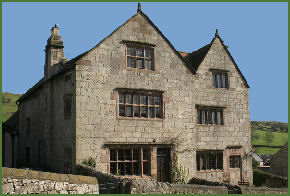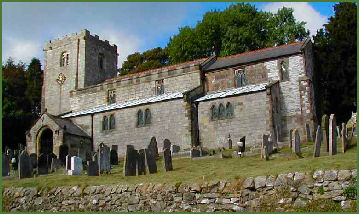Brassington
OS Grid ref:- SK231542
 Brassington, known locally as `Brass'on', is situated on a steep hillside about 7 miles from the Peak District market town of Ashbourne.
Brassington, known locally as `Brass'on', is situated on a steep hillside about 7 miles from the Peak District market town of Ashbourne.
Brassington is recorded as 'Branzingtune' in the Domesday Survey, when it was owned by Henry de Ferrers. The name is thought to derive from the Anglo-Saxon "Brandsieg's farm ".
Tudor House (pictured left) in Town Street dates back to 1615, the initials displayed on the front are those of Thomas Westerne and his wife who built the house. It served as the village inn until 1820, after which was used as a workhouse until 1848. Brassington Hall, situated on the western side of the village was constructed in the seventeenth century. The village green has a characterful old water pump and their are many cottages which date back to the seventeenth and eighteenth centuries.
 The village church of St. James is Norman, although restored and enlarged in the nineteenth century, it stands on the north side of the steep valley in which the village lies. Inside the wall of the Norman tower is an interesting relief carving, believed to be Saxon, of a man with his hand on his heart. The church font is of Norman origin. The Jacobean oak Bishops Chair is carved with the arms of the Cavendish family.
The village church of St. James is Norman, although restored and enlarged in the nineteenth century, it stands on the north side of the steep valley in which the village lies. Inside the wall of the Norman tower is an interesting relief carving, believed to be Saxon, of a man with his hand on his heart. The church font is of Norman origin. The Jacobean oak Bishops Chair is carved with the arms of the Cavendish family.
Strange rock formations can be found at Rainster Rocks, above the village, the south side of the rocks is the site of a Romano-British settlement. Enclosure walls, earthworks and the remains of a road can be seen along with fragments of its field systems.
The remote area around Brassington is rich in prehistoric remains. Just to the north of the village, on Brassington Moor, are the barrow of Minninglow, containing Neolithic burial chambers, the Barrows of Galley-Low, Slipper-Low and Blackstones-Low. During excavations carried out by Mr. Bateman in 1843, some interesting and valuable objects were discovered. Nearby is the Hoe Grange Quarry, where during the early workings a large number of prehistoric animal bones were found, including bones of the lion, elephant, bison, hyena, fallow deer and red deer.
Nearby places of interest
Dovedale, a dramatic limestone ravine, with its mpressive rock outcrops and tranquil woodlands is arguably the prettiest of the dales in the Peak District National Park and is owned by the National Trust.
The Manifold Valley, which runs almost parallel with Dovedale, has been described as the 'Switzerland of Staffordshire' and offers some of the most spectacular scenery in the Peak District National Park.
Biddulph Grange, one of Britain's most exciting and unusual gardens, was created by the horticulturalist James Bateman (1811–1897), for his large collection of plants from around the world.
Haddon Hall near Bakewell, is an architectural gem. Dating back to the eleventh century, the hall has been described as "the most complete and most interesting house of [its] period", it is the finest example of a medieval manor house currently in existence in England.
